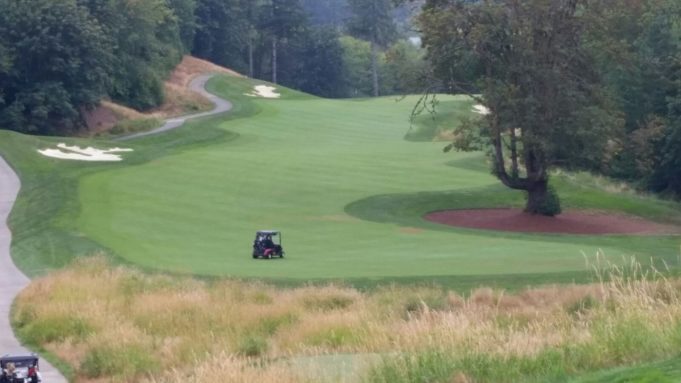If you are of the tree-hugger persuasion then I have the golf course for you. Now when I use that term I am not referring to the somewhat radical environmentalist angle (although the folks at Salish Cliffs do love their trees). I’m talking more about golfers who just flat out love trees on a course.You love the look. You love the feel. You love the smell. You might not love the sound of a ball hitting one of those trees but you still love them standing tall and unafraid of your ball.
Well if that’s you, then Salish Cliffs Golf Club, about 1.5 hours south of Seattle will easily meet that need.
I couldn’t even begin to tell you how many trees frame their fairways. It’s heaven for dogs and maybe a little confusing as there are so many to choose from. I’m sure the number is in the thousands and I did introduce myself to a few of them. OK, maybe more than a few.
Salish Cliffs came on board about five years ago, carved out of those trees by Gene Bates. It offers more than 72 hundred yards from the very back tees, about 600 feet of elevation change and a great view of the Kamilche Valley. A pretty good start don’t you think?
There is also a very strong connection between the golf course and the band who run the reservation the course is situated on. Strong connections. The tribe purchased the land to build the course through its enterprise branch. Salish Cliffs was the first salmon safe golf course. Somewhat along the lines of the Audubon society and the connection with birds.
“The land you see, there’s a lot of water that runs through this property that doesn’t have salmon in it but runs to the salmon bearing creeks so they are very concerned about what we’re doing,” said Salish Head Professional David Kass. “The Squaxin Tribe is known as the People of the Water.”
The relationship changed the way the golf course does things in order to ensure the 320 plus acres are maintained to high standards and some areas are left untouched.
“Like the area around 14, that was a debated point. It’s a peninsula shaped green but it’s got that wetlands and they did not want that touched.”
Just to the right of the driving range is another area where there is a little creek which zig zags through the property and it slowly feeds other creeks.
Even the parking lot was designed using rocks underneath in order to help the drainage into the water shed and not dump it all over the place, he said.
Back to the trees for a moment.
There was an old tree on the course which was a very good aiming point on one hole but it started to die and so it had to be taken down.
“It was planted for someone’s great grandmother so we had to take it down carefully and we actually took it and put it in a stream to help nourish the salmon,” said Kass.
When we played Salish at the end of July it was in near perfect condition in my opinion. Tee boxes and fairways were immaculate and the greens were easily the best I have putted on in years.
Kudos to the staff who handle the duties to make Salish present itself in such a positive experience manner.
Kass said it requires a big crew to keep things in order and cover such a large area.
“When we spray for weeds, put on pesticides and fungicides it’s not broadcast, they hand spray it,” he said. “So they have on back packs, walking the 320 acres so you might miss one here or there.” I never noticed.
One thing you will notice about this course is there are really 18 very different holes to challenge you in a variety of ways.
He says players will come into the clubhouse to debate which hole they liked best and it’s generally a lengthy debate.
“It’s always amazing to me some of the holes people find as their favorite,” said Kass.
Number two is one the big hitters can drive but it’s a risk/reward of course. Seventeen presents a beautiful look off the tee and a great downhill shot to start with. Both nine and 18 have players dealing with the pond near the clubhouse. Some very tough choices out there.
There are good hikes between greens and tees so a cart is generally needed but finding each hole is not a difficult task as things are mapped out quite simply. And it just flows.
“You start off with par five and then a four and then a three, then you play a couple of fours and you get another three.”
“I think it’s a really good variety. You’ve got a couple of reachable par fives with one and 18 if you hit a good tee shot in play and then you have eight and 10 which are true three shot par fives. They’re fun. It’s not just get up there and rip it off the tee and then rip it as close as you can off the green. You’ve got to start thinking your way around it.”
Same story with some of the par fours when it comes to strategy.
One of the common statements made from golf writers in reviewing a course is there are tees to hit from for every level of ability. That might be true more times than not but the next question is will hitting from your correct tee allow you to hit your second shot without putting you in a bad spot? Salish Cliffs does answer that question by having different fairway widths on some of those holes from the tees. For example, you might play one hole from the white tees and hit a long iron to lay up avoiding trouble and then move to the forward green tee and hit driver because you can clear that same trouble without risk.
Once you are done your round you can dine at the clubhouse which has some very affordable and tasty choices on the menu.
Sticking around the area is easy enough with the Little Creek Casino Resort basically next door to the course. The golf course staff will run you down to the resort in about five minutes. There you have many more food choices, a cigar bar and of course all the different forms of gaming you would find in the big city casinos.
It’s quite a good package deal to stay and play down at Salish Cliffs. Don’t let the trees get in the way.










































